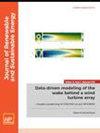带调速差动机构的风电制氢系统的优化配置和能量管理
IF 1.9
4区 工程技术
Q4 ENERGY & FUELS
引用次数: 0
摘要
混合驱动风力涡轮机(WT)可以通过使用调速差速机构(SRDM)而不是部分或完全额定的转换器来友好地连接到电网,这被认为是大规模风力发电稳定消耗的一个有前途的解决方案。为了进一步提高混合驱动WT的并网性能,本文开发了一种多源发电方案,其中集成了储氢系统(HSS),以缓解风力发电的间歇性。首先分析了所提出的风电制氢系统的总体架构和运动学原理,该系统被称为基于SRDM的WT with HSS。然后,通过能量宏观表示(EMR)方法,最终确定了数学模型的图形描述,揭示了物理特性和能量流关系。为了确保所提出的风氢方案的经济稳定运行,考虑到风电输出和负荷需求的不确定性,向HSS提出了一个有效的优化分配框架,目标是最大的年收入。还研究了几个关键HSS参数对容量分配结果的影响。此外,针对不同的系统工作模式,综合了一种能源管理方法,实现了能源与存储元件之间的交互分析和功率监控。最后,对实验和仿真案例进行了论证。结果表明了所提出的方法的有效性以及所提出的风能-氢能系统不间断并网运行的最佳性能。本文章由计算机程序翻译,如有差异,请以英文原文为准。
Optimal allocation and energy management of a wind-hydrogen generation system equipped with the speed regulating differential mechanism
The hybrid drive wind turbine (WT) can be friendly connected to the power grid by using a speed regulating differential mechanism (SRDM) instead of partially- or fully-rated converters, which has been considered as a promising solution for the stable consumption of large-scale wind power generation. To further improve the on-grid performance of hybrid drive WTs, this paper develops a multi-source power generation scheme, in which a hydrogen storage system (HSS) is integrated for mitigating the wind power generation intermittencies. The overall architecture and kinematic principles of the proposed wind-hydrogen generation system, called SRDM-based WT with HSS, are firstly analyzed. Then, the graphical descriptions of mathematical models are finalized via the Energetic Macroscopic Representation (EMR) method, by which the physical characteristics and energy flow relationships are revealed. To ensure the economical and stable operation of the proposed wind-hydrogen scheme, an effective optimal allocation framework, considering the uncertainties from wind power output and load demand, is presented to HSS, targeting the maximum annual revenue. The effects of several key HSS parameters on the capacity allocation results are also investigated. Moreover, aiming at the different system working modes, an energy management approach is synthesized to achieve the interaction analysis and power supervision between energy sources and storage elements. Finally, experimental and simulation case studies are demonstrated. Results illustrate the effectiveness of the proposed approaches and the optimal performance for uninterrupted on-grid operation of the proposed wind-hydrogen energy system.
求助全文
通过发布文献求助,成功后即可免费获取论文全文。
去求助
来源期刊

Journal of Renewable and Sustainable Energy
ENERGY & FUELS-ENERGY & FUELS
CiteScore
4.30
自引率
12.00%
发文量
122
审稿时长
4.2 months
期刊介绍:
The Journal of Renewable and Sustainable Energy (JRSE) is an interdisciplinary, peer-reviewed journal covering all areas of renewable and sustainable energy relevant to the physical science and engineering communities. The interdisciplinary approach of the publication ensures that the editors draw from researchers worldwide in a diverse range of fields.
Topics covered include:
Renewable energy economics and policy
Renewable energy resource assessment
Solar energy: photovoltaics, solar thermal energy, solar energy for fuels
Wind energy: wind farms, rotors and blades, on- and offshore wind conditions, aerodynamics, fluid dynamics
Bioenergy: biofuels, biomass conversion, artificial photosynthesis
Distributed energy generation: rooftop PV, distributed fuel cells, distributed wind, micro-hydrogen power generation
Power distribution & systems modeling: power electronics and controls, smart grid
Energy efficient buildings: smart windows, PV, wind, power management
Energy conversion: flexoelectric, piezoelectric, thermoelectric, other technologies
Energy storage: batteries, supercapacitors, hydrogen storage, other fuels
Fuel cells: proton exchange membrane cells, solid oxide cells, hybrid fuel cells, other
Marine and hydroelectric energy: dams, tides, waves, other
Transportation: alternative vehicle technologies, plug-in technologies, other
Geothermal energy
 求助内容:
求助内容: 应助结果提醒方式:
应助结果提醒方式:


